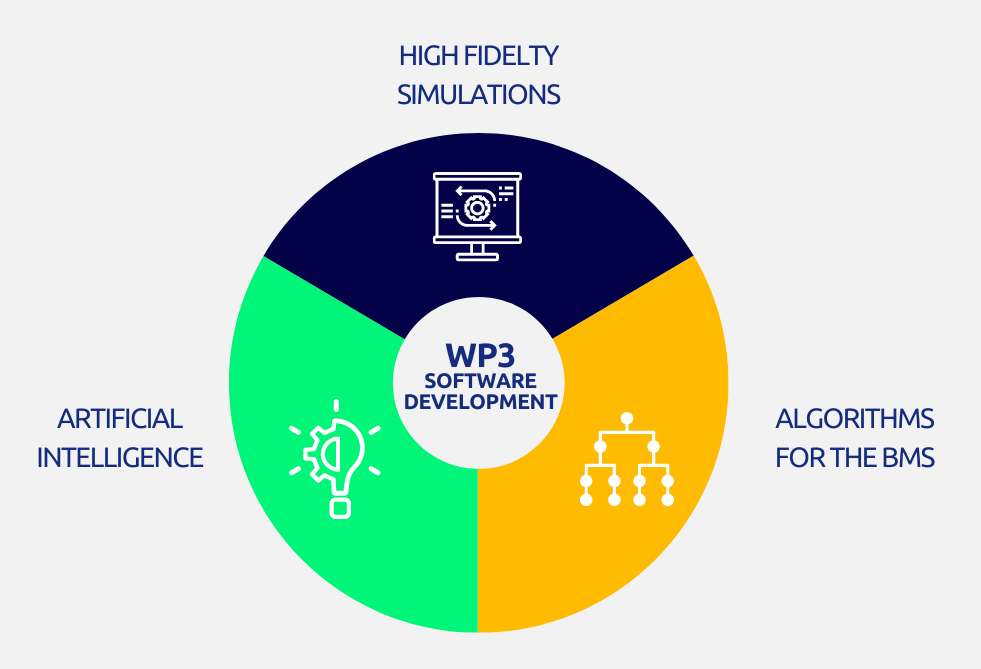As the NEXTBAT batteries project advances its mission of fostering safe and sustainable electrification in the EU, a pivotal turn is taken into the realm of cutting-edge software.
NEXTBAT is committed to driving innovation and propelling sustainable electrification through safe-by design Battery Management Systems (BMS). Launched in June 2023, as the project progresses along this trajectory, we face a major shift towards advanced software technologies. In the dynamic realm of innovative and sustainable batteries, the heartbeat lies within the intricate dance of software, orchestrating simulations, algorithms, and artificial intelligence (AI) to revolutionize energy storage.
“At the present time, NEXTBAT software is in the first stage of development (out of three total stages). Initial high-fidelity models have been designed for solving thermal propagation coupled with the fluid on well-established benchmarks”, explains David Modesto, Senior Researcher at Barcelona Supercomputing Centre (BSC) and one of the software experts behind the project.
This article delves into the ongoing efforts of Work Package 3 (WP3), led by BSC, whose software developments form the digital core of NEXTBAT. As they navigate the realms of high-fidelity simulations, orchestrate BMS algorithms, and harness the power of AI, WP3 stands at the forefront of the technological frontier, shaping the future of energy storage.

High fidelity simulations: mirroring our battery prototypes
WP3’s first pillar revolves around high-fidelity simulations, a digital realm where the immersion cooling system and thermal runaway phenomena are meticulously modelled. An analogy could be likening it to a digital laboratory, where battery prototypes conceived in WP2 (System design and prototyping) materialize.
Using the BSC multiphysics code ALYA, WP3 creates a symphony of thermal propagation and fluid mechanics on complex geometries. Then CEA and CSEM, both partners in the NEXTBAT consortium, meticulously craft the electrochemical models that serve as the core, generating the heat source for immersion cooling and thermal runaway problems.
The seamless integration of these models forms a digital twin strategy, a parallel universe mirroring the physical reality of our battery prototypes.
Algorithms for the Battery Management System: mastering the puzzle
At the core of WP3’s second pillar are algorithms for the BMS, a crucial component in NEXTBAT’s mission to enhance battery performance. Visualize a complex puzzle, where electrochemical models serve as distinct pieces waiting to be strategically placed. These algorithms, akin to skilled puzzle solvers, leverage electrochemical models to assemble a complete picture of crucial battery metrics such as state of health.
But WP3’s journey doesn’t end here, it also includes optimizing these algorithms. How? By infusing Artificial Intelligence (AI) methodologies to tackle learning tasks, drawing insights from both real data acquired during project tests and virtual data meticulously modeled.
Artificial Intelligence: the powerhouse behind sustainability
The integration of AI methodologies aligns perfectly with NEXTBAT’s vision for cutting-edge, efficient battery systems. As WP3 navigates the complexities of aging effects in BMSs, AI steps in to handle the complexities of aging effects. By applying AI methods to learning tasks, WP3 transforms the BMS into an intelligent system capable of adapting and optimizing battery performance over time. This facilitates reaching the project’s objective of enhancing battery longevity by up to 20% while maintaining an 80% state of health.
Additionally, to close the software journey in NEXTBAT, real-world data from project tests and internally modeled virtual data become the building blocks for training algorithms that can predict, optimize, and enhance battery longevity.
The NEXTBAT project is dedicated to advancing battery innovation and driving electrification in transport and mobile applications throughout the EU. Stay tuned for updates on NEXTBAT’s progress in our official social media profiles (LinkedIn and X) and subscribe to our newsletter to ensure you don’t miss any developments!
